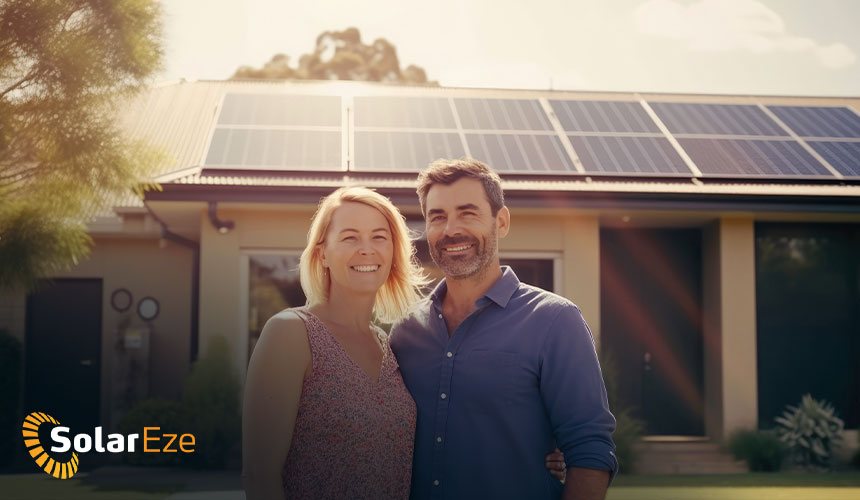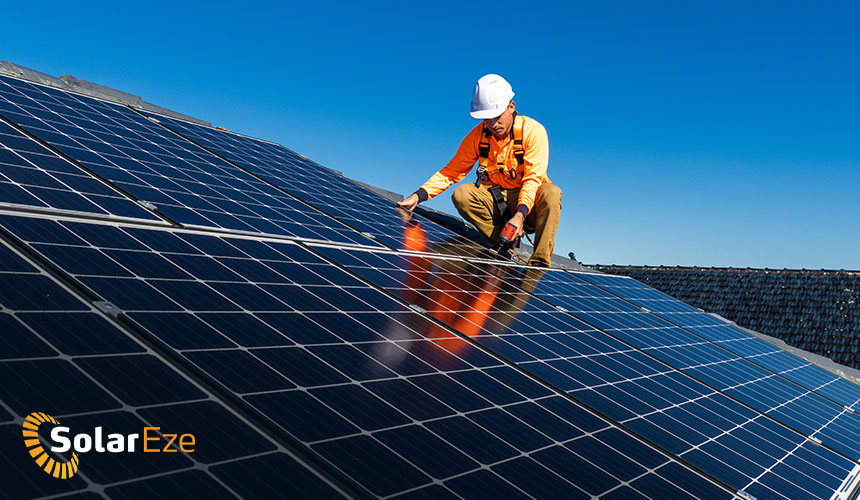Comparison Guide: Monocrystalline Vs Polycrystalline Solar Panels
Understand the differences between Monocrystalline and Polycrystalline solar panels and find out which shines brightest for your energy needs on the Gold Coast.
15+ Years Experience
Financing Available
10 Years Warranty
CEC Qualified Installers
If you’re wondering which type of solar panel to install on your Gold Coast home, you’re not alone.
In Australia’s pursuit for green solutions, understanding the difference between monocrystalline and polycrystalline solar panels becomes crucial.
This article will guide you through a detailed comparison of these two popular types. We’ll delve into their efficiency, performance under varying temperatures, and cost-effectiveness. You’ll gain insights about their lifespan and how to choose one that aligns with your roof space and budget constraints. By the end of it, you won’t just be an informed consumer but also an active contributor to our shared dream – a greener planet.
So let’s unravel this together because when it comes to smart energy choices, every bit counts!
Key Takeaways
- Monocrystalline panels are more efficient but more expensive, while polycrystalline panels are less efficient but more affordable.
- Monocrystalline panels have a longer lifespan of 30-40 years, while polycrystalline panels last 25-35 years.
- Monocrystalline panels have higher efficiency ratings of 15%-25%, while polycrystalline panels have lower ratings of 14%-17%.
- Monocrystalline panels have a lower temperature coefficient and work well in heat, while polycrystalline panels have a higher temperature coefficient and are less productive in hot temperatures.
Understanding Solar Panel Types
Imagine you’re at a bakery, torn between two types of bread – the pricier artisanal loaf and the more affordable but slightly less appetising factory-made one. That’s pretty much what it feels like when deciding between monocrystalline and polycrystalline solar panels.
You see, monocrystalline panels are like that pricier loaf; they’re made from a single silicon crystal which makes them more efficient, but also costlier. On the other hand, polycrystalline panels are akin to the factory-made bread; they’re created using multiple silicon fragments melted together making them less efficient but definitely lighter on your wallet.
The choice between these two boils down to assessing monocrystalline vs polycrystalline efficiency, temperature coefficient comparison, and understanding the importance of performance ratio. While monocrystalline panels offer higher efficiency rates due to their purity, their temperature coefficient is lower than polycrystalline ones meaning they perform better in high heat conditions. The performance ratio helps evaluate how well these panels convert sunlight into electricity under real-world conditions.
When selecting the right PV module for your home or business needs, remember that cost and value might not always align perfectly. High upfront costs may translate into greater energy savings over time with mono-panels whereas poly-panels could be an economical start for those tight on budget. Treading this path of panel selection requires astute judgment about long-term benefits versus immediate expenditure.
Our next discussion will delve deeper into ‘efficiency and performance’ shedding light on why it’s crucial in your decision-making process.
Efficiency and Performance
Think about how much more energy you could generate by installing a more efficient solar system, it’s like getting a bonus on your investment! Take monocrystalline panels for instance. They’re known for their superior efficiency and high energy output compared to polycrystalline panels. This is primarily due to the single, high-purity silicon crystal used in each cell.
When considering durability and lifespan, both types perform well but mono panels slightly edge out poly ones. They can last up to 40 years if maintained properly – a testament to their robust construction. Speaking of maintenance and upkeep, both types are relatively low hassle although mono panels tend to be less prone to dirt accumulation thanks to their sleek surface.
In terms of environmental impact, the manufacturing process of monocrystalline panels is more energy-intensive, but they compensate by providing higher efficiency over time. Regarding installation considerations, fewer mono panels are needed for the same power output due to their higher efficiency which means less roof space is required.
Remember though that every home setup is unique so you should consider all these factors when deciding between monocrystalline and polycrystalline solar panels. Now let’s delve into another crucial factor: temperature coefficient— an aspect often overlooked but vital in optimising panel performance.
Temperature Coefficient Explained
Let’s not beat around the bush here, folks – in the hot and steamy world of temperature coefficients, it’s not just about who looks good on paper but also who can keep their cool when things heat up. You see, solar panels aren’t immune to temperature impact. In fact, their performance in the hot conditions of South East Queensland can significantly affect real-world power production.
Monocrystalline panels have a slightly better temperature coefficient compared to polycrystalline ones. What this means is they handle elevated temperatures with more grace. But don’t let that sway you too much! The difference between these two types of panels at a scorching 65°C is barely noticeable.
But watch out for manufacturer claims here. Not all companies are as reliable or transparent in reporting their products’ resilience against heat. It’s always wise to trust brands with an established Australian presence and consistent independent test results. You should also discuss which panel will perform best on your roof with your Gold Coast solar installer.
Remember, though: while this characteristic is important, it shouldn’t be your primary concern when choosing between monocrystalline and polycrystalline solar panels. What matters most is overall panel performance and getting bang for your buck! Moving forward, we’ll explore how to evaluate the performance ratio of different solar panels effectively.
Evaluating Performance Ratio
So you’re probably wondering, ‘What’s this performance ratio all about and how does it affect my choice of solar panels?’ Well, think of the performance ratio as a tool for comparing real-world performance against the manufacturer’s specifications. It’s like putting your solar panels through a rigorous field test to see if they can walk the talk.
When you are in the process of evaluating different types of solar panels, a thorough performance ratio analysis is crucial. This gives you an indicator of how well your chosen panel will perform under actual environmental conditions versus what’s stated on paper by the manufacturers. Don’t just rely on their claims; instead, look for independent tests that provide unbiased results.
Brand reliability also plays a significant role in this context. A trusted brand with an Australian presence is likely to demonstrate better quality control and adherence to its declared specifications. Moreover, Australian presence impact means easier access to customer service or warranty considerations.
So before making any decisions based solely on efficiency or temperature coefficient, take time to understand this key specification. Next up? We’ll delve deeper into choosing a photovoltaic (PV) module that best suits your energy needs and budget constraints without compromising on quality or performance.
Choosing a PV Module
When it comes to picking the right PV module, there’s more to consider than just poly versus mono. The brand of your solar panels can have a significant impact on their performance and longevity. So, conduct a thorough brand comparison before making your decision.
- Brand Comparison: Not all solar panels are created equal. Some brands offer superior quality and performance, while others might provide better value for money. Researching different brands helps you understand what each offers in terms of efficiency, reliability, and customer satisfaction.
- Warranty Analysis: A solid warranty is crucial when investing in solar panels as it protects you against any unforeseen issues or defects that could occur over time.
- Performance in Different Climates: How well do the panels perform under various weather conditions? This is particularly important if you live in an area with extreme temperatures or weather patterns.
User reviews can provide additional insights into how the panels perform once installed, including durability concerns or installation process difficulties not covered by manufacturers’ specifications or warranties.
Now that you’re equipped with this knowledge, remember: choosing the right panel isn’t just about cost—it’s also about value for your investment. Now let’s shift our focus towards understanding cost and value assessment of these solar options in further detail.
Cost and Value Assessment
Now that we’ve shed some light on selecting the right PV module, let’s dive deeper into the cost and value assessment of monocrystalline and polycrystalline solar panels. Your budget considerations undoubtedly play a crucial role in this decision-making process – a comprehensive pricing analysis is key here.
Monocrystalline Solar Panels
While monocrystalline panels have a higher upfront cost due to their complex manufacturing process, they offer superior efficiency rates. This means you’ll likely need fewer panels to meet your energy requirements, which can offset the initial investment.
Polycrystalline Solar Panels
On the other hand, polycrystalline panels are more affordable initially but might require more roof space due to their lower efficiency rates. It’s not just about immediate costs; consider your return on investment too.
Long-term Savings
Your long-term savings should be factored into your decision as well. Monocrystalline panels tend to last longer and perform better in high-temperature conditions, potentially leading to greater energy savings over time.
Cost-effectiveness Comparison
In terms of cost-effectiveness comparison, it really boils down to your specific needs and circumstances: how much roof space you have available and what kind of climate you live in could tip the scales one way or another.
Next up? We’re going beneath surface appearances by exploring independent testing results for these two types of solar panels.
Independent Testing Results
Let’s dive right into the meat of the matter – independent testing results. You might be wondering why this is important, well, it could make all the difference in your decision-making process. When you’re comparing monocrystalline and polycrystalline solar panels, reliable testing can provide valuable insights about their performance under various conditions.
Independent testing offers unbiased results that cut through the marketing hype of different manufacturers. It provides accurate information about panel efficiency, durability, and power output based on real-world scenarios rather than controlled laboratory settings. Such findings help you compare brand performances side by side so you can see how they stack up against each other.
When evaluating test results, pay attention to parameters like temperature coefficient and performance ratio. These metrics offer key insights into panel’s productivity under hot conditions and its real-world power production compared to manufacturer specifications respectively. Remember, a good solar panel isn’t just about high-efficiency numbers; it should also perform consistently under diverse environmental conditions.
So don’t just rely on manufacturer claims or price tags when choosing between monocrystalline and polycrystalline panels. Make sure you explore independent testing data—it’s one of your best tools for making an informed decision!
SolarEze: The Trusted Solar Installers on the Gold Coast
Navigating the solar panel maze can be daunting. But with SolarEze, you’re never alone in making this pivotal choice for a brighter and greener tomorrow.
Why choose us?
- 15 Years of Solar Expertise: SolarEze isn’t just a company; it’s a wealth of 15 years of knowledge, ensuring we guide you correctly.
- CEC Accredited: We’re accredited by the Clean Energy Council, reinforcing our commitment to high-quality solar solutions.
- Glittering Reviews: Over 300 5-star reviews can’t be wrong. Trust in our proven track record and unmatched service quality.
- Guaranteed Peace of Mind: We back our services with a 10+ year warranty, ensuring you have peace of mind for a decade and beyond.
- Flexible Financing: We believe in making green energy accessible to all. With our affordable financing options, transitioning to solar has never been easier.
If you’re contemplating monocrystalline vs. polycrystalline solar panels, call us on 0410 658 790 to organise a FREE in-home consultation and quote.
Visit www.solareze.com.au to request a quote for your next solar installation and one of our friendly team members will contact you shortly. If you would like to talk to us immediately, call 0410 658 790 today and we will offer you a free solar consultation for your home.







No Comments